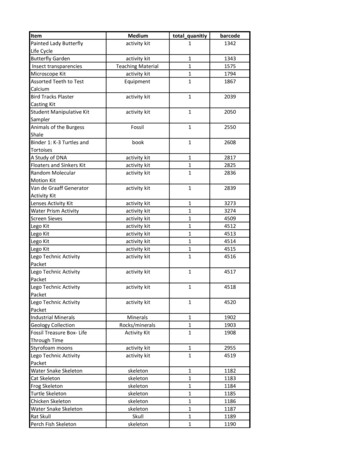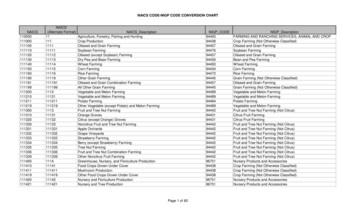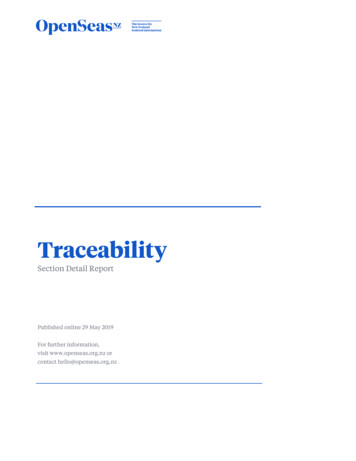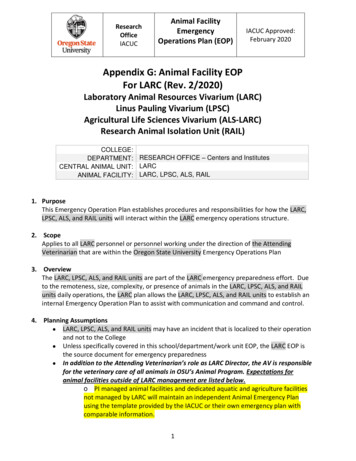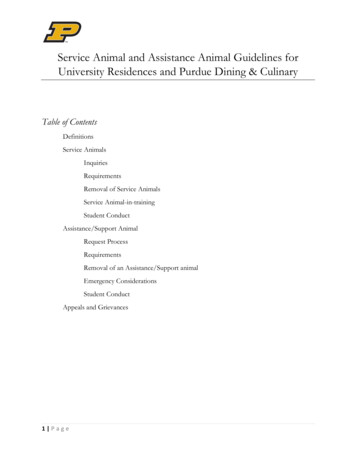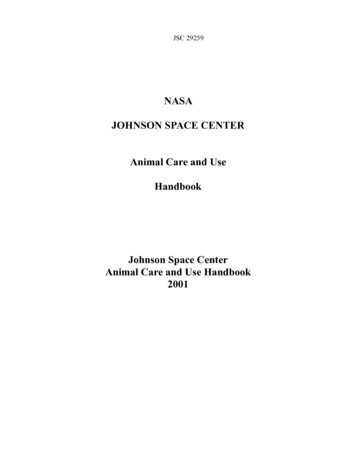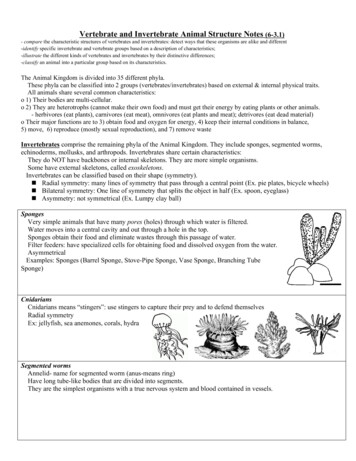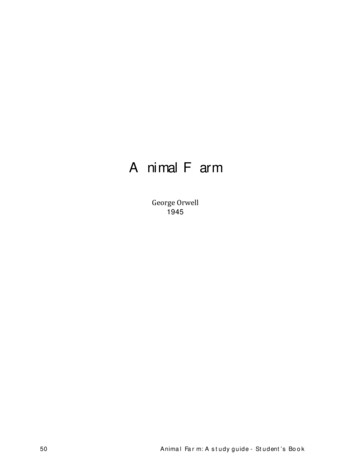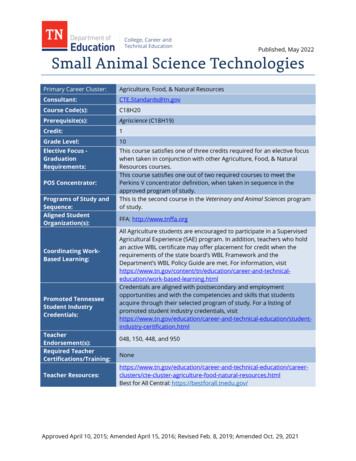
Transcription
Published, May 2022Small Animal Science TechnologiesPrimary Career Cluster:Agriculture, Food, & Natural ResourcesConsultant:CTE.Standards@tn.govCourse Code(s):C18H20Prerequisite(s):Agriscience (C18H19)Credit:1Grade Level:10Elective Focus GraduationRequirements:This course satisfies one of three credits required for an elective focuswhen taken in conjunction with other Agriculture, Food, & NaturalResources courses.This course satisfies one out of two required courses to meet thePerkins V concentrator definition, when taken in sequence in theapproved program of study.This is the second course in the Veterinary and Animal Sciences programof study.POS Concentrator:Programs of Study andSequence:Aligned StudentOrganization(s):Coordinating WorkBased Learning:Promoted TennesseeStudent IndustryCredentials:TeacherEndorsement(s):Required TeacherCertifications/Training:Teacher Resources:FFA: http://www.tnffa.orgAll Agriculture students are encouraged to participate in a SupervisedAgricultural Experience (SAE) program. In addition, teachers who holdan active WBL certificate may offer placement for credit when therequirements of the state board’s WBL Framework and theDepartment’s WBL Policy Guide are met. For information, redentials are aligned with postsecondary and employmentopportunities and with the competencies and skills that studentsacquire through their selected program of study. For a listing ofpromoted student industry credentials, 48, 150, 448, and lture-food-natural-resources.htmlBest for All Central: https://bestforall.tnedu.gov/Approved April 10, 2015; Amended April 15, 2016; Revised Feb. 8, 2019; Amended Oct. 29, 2021
Course-At-A-GlanceCTE courses provide students with an opportunity to develop specific academic, technical, and 21stcentury skills necessary to be successful in career and in life. In pursuit of ensuring every student inTennessee achieves this level of success, we begin with rigorous course standards which feed intointentionally designed programs of study.Students engage in industry relevant content through general education integration andexperiences such as career & technical student organizations (CTSO) and work-based learning (WBL).Through these experiences, students are immersed with industry standard content and technology,solve industry-based problems, meaningfully interact with industry professionals and use/produceindustry specific, informational texts.Using a Career and Technical Student Organization (CTSO) in Your ClassroomCTSOs are a great resource to put classroom learning into real-life experiences for your studentsthrough classroom, regional, state, and national competitions, and leadership opportunities. Beloware CTSO connections for this course. This is not an exhaustive list. Participate in CTSO Fall Leadership Conference to engage with peers by demonstratinglogical thought processes and developing industry specific skills that involve teamwork andproject management. Participate in FFA career and leadership events (CDE/LDE) that align with this courseincluding Agriscience Fair, Agricultural Communications, Agricultural Issues, Dairy Evaluation& Management, Employment Skills, Extemporaneous Speaking, Horse Evaluation, LivestockEvaluation, Meats Evaluation & Technology, Parliamentary Procedure, Poultry Evaluation,Public Speaking, and Veterinary Science.For more ideas and information, view https://tnffa.org/.Using Work-based Learning (WBL) in Your ClassroomSustained and coordinated activities that relate to the course content are the key to successful workbased learning. Possible activities for this course include the following. This is not an exhaustive list. Standards 1.1-2.4 Invite an animal scientist to discuss the history and trends within theindustry. Standards 3.1-3.4 Tour a veterinary hospital or clinic. Standards 4.1-5.2 In groups, virtually collaborate with animal caretakers or an animalscientist to prepare an educational presentation on how to care for specific small animalsproperly. Standards 6.1-6.3 Invite an animal nutritionist to discuss the aspects of proper animalhealth. Standards 7-1.-7.2 Invite an animal geneticist or breeder to discuss the role of genomics inreducing animal disease. Standards 8.1-10-1 Invite a pet store manager, veterinarian assistant, or breedrepresentative to present skills associated with fundamental care and health for specificbreeds of animals.May 2022 Page 2
Course DescriptionSmall Animal Science Technologies is an intermediate course in animal science and care for studentsinterested in learning more about becoming a veterinarian, vet tech, vet assistant, or pursuing avariety of scientific, health, or agriculture professions. This course covers the anatomy andphysiological systems of different groups of small animals, as well as careers, leadership, and historyof the industry. Upon completion of this course, proficient students will be prepared for moreadvanced coursework in veterinary and animal science.Course Standards1. History of Domestication1.1 History of Small Animal Domestication: Research the history of small animaldomestication including defining and applying industry-specific terminology to classifyanimals in the correct taxonomy. Justify the historical uses and roles of domesticatedanimals, and compare historical processes of small animal domestication.2. Economic, Occupational, and Technological Implications2.1 Economic Implications: Determine the general economic impact of the small animalindustry by investigating both home and business implications.2.2 Career Exploration: Explore and compare local and regional career opportunities in thesmall animal industry. Describe the knowledge, skills, and abilities necessary for a diverserange of careers in small animal sciences.2.3 Financial and SAE Recordkeeping: Accurately maintain an active recordkeeping system andapply proper accounting and financial records as they relate to a small animal sciencesupervised agricultural experience (SAE) program or enterprise. Demonstrate the abilityto summarize business records such as individual enterprise budgets, profit and lossstatements, inventory management, transportation cost, and other specific reports bycompleting SAE and related financial applications.2.4 Emerging Technologies: Examine specific emerging technologies that have evolved withinthe small animal industry (such as, but not limited to, equipment, procedures, andhealthcare) and evaluate the economic and societal implications of each.3. Personal and Occupational Health and Safety3.1 Diseases: Identify, research, and determine the significance of zoonotic diseases associatedwith small animals. Compare and contrast findings relating to a specific disease. Justify theuse of different methods of infection control in the prevention or management of zoonoticdiseases and evaluate the efficacy of existing small animal biosecurity measures.May 2022 Page 3
3.2 Health Requirements and Regulations: Identify and summarize laws and regulations thatpertain to small animal health and safety from state and national legislation. Describe healthrequirements and necessary documentation for small animal transportation and change ofownership.3.3 Safety and Operational Procedures: Review common laboratory safety procedures fortool and equipment operation in the small animal science laboratories, including but notlimited to accident prevention and control procedures. Demonstrate the ability to followsafety and operational procedures in a lab setting and complete a safety test with 100percent accuracy.3.4 Personal and Animal Safety Practices: Demonstrate the ability to follow proceduresprecisely, attending to special cases or exceptions noted in appropriate materials, and applythem to the following areas:a. Animal restraint and handlingb. Techniques for transportationc. Appropriate use of chemicals (such as pesticide, fungicide, disinfectants)d. Differentiate between effective methods for handling small animals and methodsproven to be less effective.4. Responsible Pet Ownership4.1 Financial and Legal Responsibilities: Research the benefits and responsibilities of petownership, including factors to consider when choosing a pet. Compare and contrastavailable sources for obtaining a pet, identifying and summarizing common lawsgoverning pet ownership, and investigating the societal and economic issues that mayimpact pet owners.4.2 Ethical Care: Compare and contast the characteristics of responsible pet ownership withownership practices that have been shown to be negligent or inappropriate. Explainwhy certain practices fail and others succeed. Discussion topics may include:a. Training and behavior managementb. Housing, boarding, and transportingc. Breedingd. Feeding and nurturinge. Management of health conditionsf. Matching of animal type/breed and owner lifestyle (including living conditions,geographic location, and number and age of family members)5. Animal Ethics5.1 Fundaments of Animal Rights and Welfare: Identify the fundamental philosophies relatedto animal rights and animal welfare. Compare the impact of specific persons,organizations, and legislation related to animal rights and welfare of small animals, citingspecific textual evidence.May 2022 Page 4
5.2 Analyzing Ethical Issues: Debate specific issues related to animal rights and animalwelfare by forming claims and counterclaims with specific data and evidence. Issues mayinclude, but are not limited to:a.Abuse and/or neglectb.Illegal capture and/or tradec.Overpopulationd.Control of populationse.Euthanasiaf.Exhibiting and showingg.Global issues in small animal ethics and their relation to local problems.6. Nutrition and Digestive Systems6.1 Digestive System Identification: Differentiate between ruminant and non-ruminantanimals, comparing and contrasting their anatomical and physiological differences of smallanimals.6.2 Nutritional Requirements: Research nutrient requirements of small animal diets andorganize these into various nutrient groups. Interpret feed labeling and evaluate factorssuch as life stage and activity level to determine the nutritional needs to recommendbalance rations for small animals, justifying recommendations with evidence.6.3 Nutritional Diseases: Distinguish among the symptoms of nutritional diseases relevant tosmall animals and recommend the appropriate control procedures.7. Genetics, Reproduction, and Genomics7.1 Reproductive Systems: Research the major components of male and female reproductivesystems in small animals and prepare a short narrative to distinguish the function ofreproductive organs, endocrine glands, and hormones. Summarize the physiologicalchanges that occur during reproductive phases, including the estrus cycle, fertilization,gestation, parturition, and lactation.7.2 Principles of Genetics and Genomics: Explain how the fundamental principles of geneticsand genomics apply to the study of small animals. Principles should include aspects of theconcepts of inheritance, gene transfer, lineage tracing of bloodlines, mapping of traits, andmapping of diseases.8. Fundamental Care and Health of Dogs and Cats8.1 Domestication, Care, and Health: Synthesize research on the historical importance of dogsand cats, noting major economic, social, and medical advances impactingdomestication. Differentiate between the defining characteristics of the common dog andMay 2022 Page 5
common cat breeds. Demonstrate conceptual understanding and technical skill in currentpractices of comprehensive health care and management for the following:a. Precisely follow effective grooming procedures and techniques to maintain healthyskin, coat, nails, eyes, and earsb. Design appropriate facilities based on an assessment of needsc. Identify appropriate owner/handler responses to behaviors and instincts to ensurethe safety of both individual and small animal in a variety of situationsd. Distinguish between clinical signs of proper health and poor health, justifyingexplanations with data and evidencee. Calculate feed rations based on animal characteristics (age, weight, breed, activitylevel) and nutritional needsf. Illustrate the reproductive cycle graphically, and summarize available breedingmethods and current reproductive technologiesg. Research common diseases and parasites and their effects on the health of dogs andcats, and draw evidence from relevant medical literature to recommend the bestprevention or control measures.9. Fundamental Care and Health of Rabbits, Guinea Pigs, Chinchillas, and Rodents9.1 Domestication, Care, and Health: Synthesize research on the historical importance ofrabbits, guinea pigs, chinchillas, and rodents, noting major economic, social, andmedical advances impacting domestication. Differentiate between their definingcharacteristics. Demonstrate conceptual understanding and technical skill in currentpractices of comprehensive health care and management for the following:a. Precisely follow effective grooming procedures and techniques to maintain healthyskin, coat, nails, eyes, and earsb. Design appropriate facilities based on an assessment of needsc. Identify appropriate owner/handler responses to behaviors and instincts to ensurethe safety of both individual and small animal in a variety of situationsd. Distinguish between clinical signs of proper health and poor health, justifyingexplanations with data and evidencee. Calculate feed rations based on animal characteristics (age, weight, breed, activitylevel) and nutritional needsf. Illustrate the reproductive cycle graphically, and summarize available breedingmethods and current reproductive technologiesg. Research common diseases and parasites and their effects on the health of rabbits,guinea pigs, chinchillas, and rodents, and draw evidence from the most recentmedical literature to recommend the best prevention or control measures.10. Fundamental Care and Health of Avians, Fish, Amphibians, and Reptiles10.1 Domestication, Care, and Health: Synthesize research on the historical importance ofavians, fish, amphibians, and reptiles, noting major economic, social, and medicaladvances impacting domestication. Differentiate between their defining characteristics.Demonstrate conceptual understanding and technical skill in current practices ofcomprehensive health care and management for the following:May 2022 Page 6
a. Precisely follow effective grooming procedures and techniques for applicable speciesb. Design appropriate facilities based on an assessment of needsc. Identify appropriate owner/handler responses to behaviors and instincts to ensurethe safety of both individual and small animal in a variety of situationsd. Distinguish between clinical signs of proper health and poor health, justifyingexplanations with data and evidencee. Calculate feed rations based on animal characteristics (age, weight, breed, activitylevel) and nutritional needsf. Illustrate the reproductive cycle graphically, and summarize available breedingmethods and current reproductive technologiesg. Research common diseases and parasites and their effects on the health of birds,fish, amphibians, and reptiles, and draw evidence from the most recent medicalliterature to recommend the best prevention or control measures.Standards Alignment NotesReferences to other standards include: SAE: Supervised Agricultural Experience: All Agriculture students are encouraged toparticipate in a Supervised Agricultural Experience program to practice and demonstrate theknowledge and skills learned in their agriculture courses. AFNR: National Agriculture, Food, & Natural Resources (AFNR) Career Cluster ContentStandards: Students engaged in activities outlined above should be able to demonstratefluency in Standards AS at the conclusion of the course. P21: Partnership for 21st Century Skills Framework for 21st Century Learningo Note: While not all standards are specifically aligned, teachers will find theframework helpful for setting expectations for student behavior in their classroomand practicing specific career readiness skills.May 2022 Page 7
advanced coursework in veterinary and animal science. Course Standards : 1. History of Domestication : 1.1 History of Small Animal Domestication: Research the history of : . statements, inventory management, transportation cost, and other specific reports by completing SAE and related financial applications. 2.4 Emerging Technologies: Examine :
